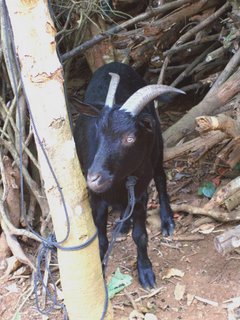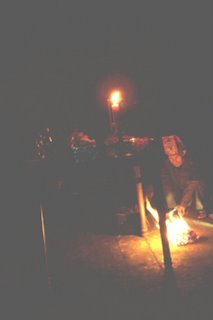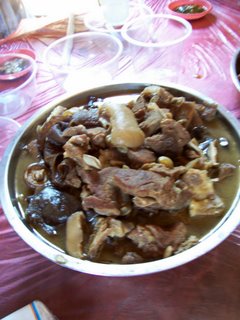
I caught sight of a goat when I was at Hainan earlier this month. I was told that the goat was a mountain goat. This goat did not like taking photographs. It tried to shun away whenever I release the camera shutter.
Anyway, I managed to steal a shot of the mountain goat. This photograph has been digitally enhanced. This is necessary so as to brighten the image. The reason is that I realised that the mountain goat was afraid of flashlight, and I had to refrain from using flashlight.
When I used flashlight to take a photograph of this mountain goat, guess what had happened? The mountain goat's reflex action was to pee. My mother told me this had happened because the mountain goat was frightened by the flashlight.
I have a feeling that this mountain goat is probably a male goat? Could anyone help to confirm this please?
Warning note: The story of the mountain goat shall start after this paragraph. However, if you are an animal right activist or cannot bear to witness scenes of an animal being slaughtered, I ask that you refrain yourself from reading any further. I am writing this post from the point of an observer who has in some way, participated in the story.
****
This mountain goat was tied to a tree trunk when I had first caught sight of it. Do you know why it was found at the village? I was told that it is a rare thing for the villagers to eat mutton or beef. Then why is the goat there?
It was meant as a sacrificial item for a ritual that were to take place before dawn of the following day. I was told that the following day (10 Nov 2006) was a good day for the ritual. I think it must have been a Chinese traditional belief that a good day must be chosen for such special occasion.
The ritual, as I understood, was meant as a Thanksgiving ritual. This ritual was to pray to the ancestors and to the goddess, Ma-zu, to thank them for the safe arrival of my parents and myself. It was also meant to pray and ask for a safe journey back to Singapore. The ritual is considered quite a big affair because after the ritual, the meat of the goat would be distributed amongst all the households in the village.
***
It was probably about 2 or 3 a.m. of 10 Nov 2006. I was awaken by the sounds of firecrackers. My mother told me that the ritual was to begin soon.
Here's yet another digitally enhanced photo. Here's what I saw at the wee hours of the day:

I did not ask much questions. I was told that the goat would be slaughtered very soon. Before the goat was slaughter, I saw my uncle pulling the mountain goat to an altar. He got the goat to bow at the altar for three times. The man whom you had seen in the photograph right above would chant some phrases. Afterwhich, the goat was taken to slaughter. I heard it crying sounds of resistance. I decided I shall not witness the slaughter. A chicken was also slaughtered at about the same time as the mountain goat. My mother asked that I take photographs of the slaughter of the mountain goat. I decided I shall not.
Later, I decided to muster some courage to witness what would follow next.
After the goat was slaughtered (but I did not witness it), I saw a male and a female removing the goat of its hairs. I was told that the male and female persons that I had seen were specially engaged by my relatives to slaughter the goat. The male and female persons were related to each other as husband-and-wife.
In the process of removing the hairs from the goat, hot water was used. The male and female persons also used their hands to pull the hairs off the slaughtered goat. In addition, razor-blades that looked like those used to shave hair was also used. The skin of the black-haired goat was white, I discovered.

After a while, the goat was skinned. It was then prepared to be used for the ritual. I shall warn my readers not to read on further unless they are open-minded enough to accept that what one is going see following this sentence is one custom that is being practised by a group of Chinese to pray for safety. While it has not much of a significance to me, it has a deep significance to those who subscribe to practising the ritual. My uncle told me that he felt a sense of peace of the mind and heart when he had the ritual performed.

The leaf-looking thing in the mouth of the slaughtered goat was papaya leaf, if I had remembered correctly. It was meant to represent something like prosper of one's offsprings. The round circular flat item just next to the slaughtered goat was its blood coagulated to form a circular block.

I just could not fully appreciate and comprehend how the sacrifice of the goat was necessary to pray for one's safety. Then again, I am aware that there are religions whereby the sacrifice of goats is being practised for one reason or another.

Maybe not-wasting is a virtue to the villagers here? After the goat was slaughtered, even the internal organs were not thrown away. Look at the photo right above and you would see the internal organs (stomach and etc.) of the goat.
I shall not attempt to write much about the ritual here. This post is afterall the story of the goat. Sometime after the ritual, I saw a man trying the prepare to cut the meat of the goat into smaller pieces. This man was engaged to cook the meat of the goat. Another man helped out later. I was told that this other man is one of my distant relatives.



I beg your pardon, that was probably my first time witnessing the preparation of mutton.
I was told that the meat of the goat was being placed in the pot that you would see in the photo below. To make mutton-stew, I suppose?

Several hours later, this was the Hainanese mutton stew that I saw on the table for lunch that day. I ate some of it. This was how I had participated in this story: part of the mountain goat was assimilated by my digestive system. The meat was very fresh and tender and had a nice mutton taste to it. The stew was full of nice flavour. I guess it would be difficult for me to get to eat mutton that fresh in Singapore?

Before the trip, I had heard about pig brains, but I did not have any awareness that goat's brain can also be eaten. One of my paternal aunts offered me a small portion of goat brain after she had passed a bowl of goat brain to my paternal grandmother to eat. According to my aunt, the goat brain is soft and does not require much chewing. I tried, and it was. The goat brain was cooked together with quite a fair amount of rock sugar. As such, the yellowish white syrup that you see in the photo below was actually very sweet.

That day, I can better appreciate this saying that the Chinese would turn anything to a delicacy so long as it has four limbs.
3 comments:
Thanks for this. Very enlightening post. But ugh, I don't think I could make myself eat the brains of anything!
thank you for sharing the story and posting the pics here. i have to admit i was a little afraid to read the post, after your warning. but it turned out quite alright.
Thanks for sharing this ritual. While I understand that every culture has its own rituals and beliefs, it does not necessarily mean that I agree with each and every one of them.
This ritual is meant to bring peace and safety, but at what costs? Such pain and horror had been inflicted on an innocent creature (one that doesn't harm us in any way).
It is a common and probably essential practice among Chinese to sacrifice animals, but such a cruel act with no regard for animal life only increases my disdain towards Chinese even more.
I have already become a semi-vegetarian, eating only chicken and seafood. After this, I think I'm gonna stop eating chicken altogether (sea creatures have a different nervous system and may not feel pain).
(Note: Don't get me wrong, I have nothing against you and your post. In fact I am so grateful that you have shared the information and pictures with us readers, and glad for the fact that I am now more enlightened about such rituals. These are things that we hear of but to see them in pictures is a totally different thing.)
Post a Comment